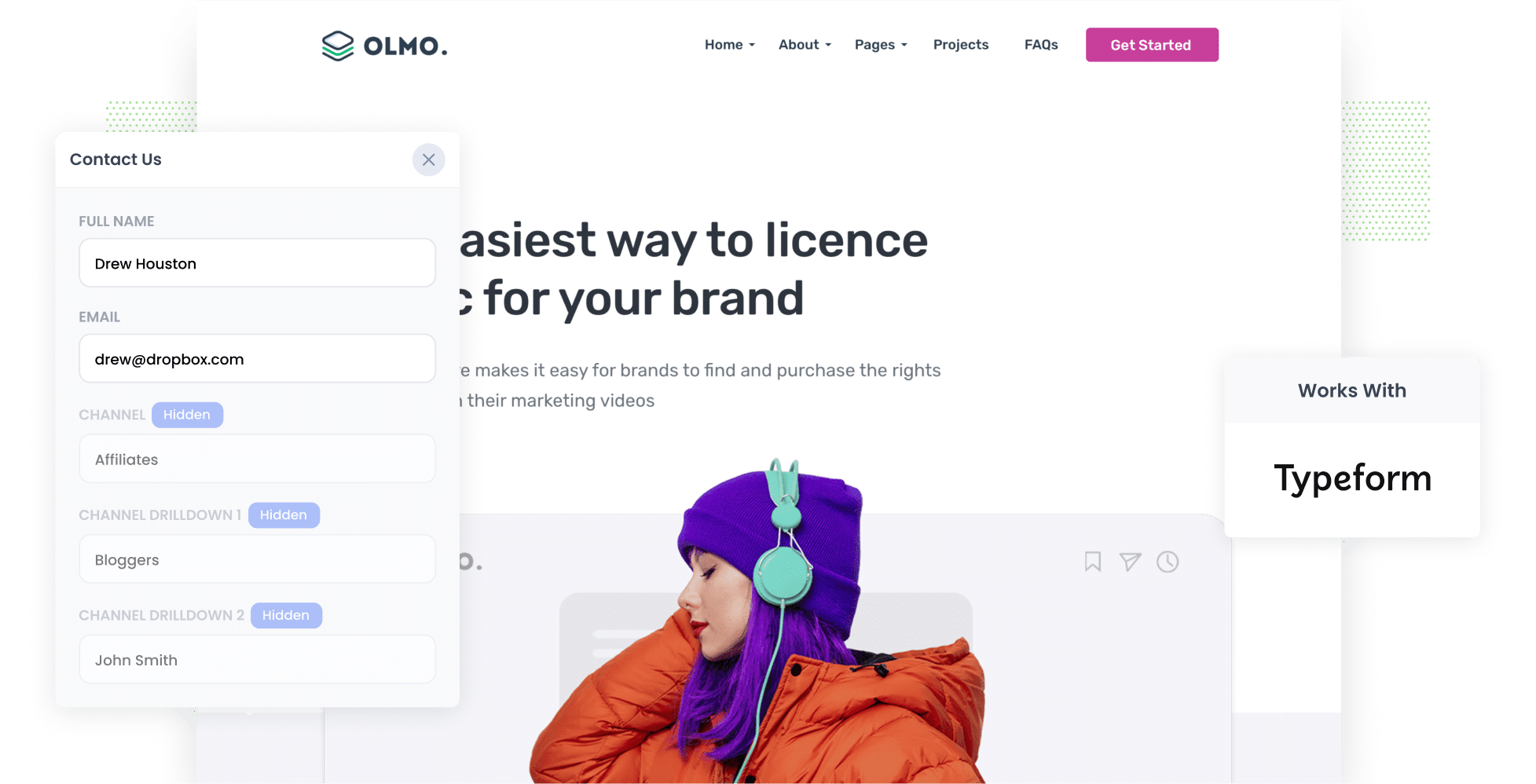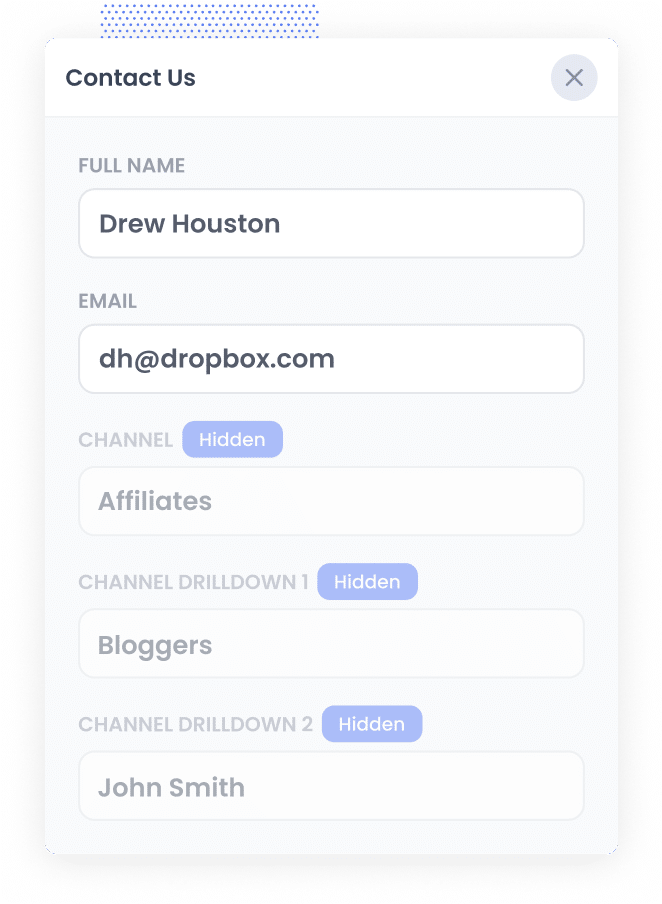How to track leads from Affiliates in Typeform
Learn how to capture Affiliate data with each submission of your Typeform forms, so you can see which affiliates are generating the most leads.

In the early stages of my career, I was working for a software company and we were struggling to track the number of leads and customers our affiliate program was generating.
I could open Google Analytics and easily see how many website visitors it had driven, but when I opened up the CRM, there was no data about where our leads were coming from.
As a result, I had no way of reporting back to my boss the exact amount of leads, customers & revenue our affiliate program was generating.
So I decided to change that (both for me and for others).
In this article, I will show you how to capture Affiliates' data in Typeform in four simple steps, as well as some reports I’ve run in the past that I think you’ll find useful.
4 simple steps to capture affiliate data in Typeform
When you use Attributer with Typeform, you can see how many leads and customers come from your affiliate program. It’s super simple, here's the deal.
1. Add UTM parameters to your affiliate links

The first step is to add some UTM parameters to the links you share with your affiliates. For example, if you want them to link to attributer.io/integrations/typeform, the link you give them could look like this:
attributer.io/integrations/typeform?utm_medium=affiliates&utm_source=bloggers&utm_campaign=john-smith
You can tweak the UTMs based on the info you want to collect about your affiliates, but we suggest keeping it pretty simple and sticking to something like this:
- UTM_Medium = Affiliates
- UTM_Source= Bloggers (or the type of affiliate this is, such as bloggers, podcasters, YouTubers, etc.)
- UTM_Campaign= John-Smith (or the name of the specific affiliate)
Platforms like Trackdesk or Rewardful can easily tack UTM parameters onto the links you share with your affiliates and you can use our free UTM builder to create the UTM-tagged links (it has templates made just for Affiliates).
2. Add hidden fields to your forms

Next up, you’ll want to add some hidden fields to the Typeform forms on your website.
Here are the hidden fields you should add:
- Channel
- Channel Drilldown 1
- Channel Drilldown 2
- Channel Drilldown 3
- Landing Page
- Landing Page Group
Luckily, Typeform makes it super easy to do, and you can see step-by-step instructions here.
3. Attributer writes the affiliate data into the hidden fields

When someone visits your site through one of your affiliate links with UTM parameters, Attributer grabs and saves those UTM parameters in their browser.
This means they can explore your site or even leave and return later, and the UTM parameters from their first visit will always be remembered.
Then, when they fill out a form on your site, Attributer automatically writes the affiliate info from the UTM parameters into the hidden fields of the form.
4. Affiliate data is captured by Typeform

Finally, when someone submits the Typeform form on your site, Typeform captures the affiliate data that the Attributer wrote into the hidden fields along with the person's details, like their name and email.
What you can do with the data
Now that the Affiliate data is being collected through Typeform, what can you do with it? Here are some ways to make the most of it:
- Send it to your CRM: You can send the affiliate data into your CRM system, like Salesforce, Hubspot, or Pipedrive. This way, you can easily whip up reports that show how many leads came from your affiliate program, how many of those turned into paying customers, the revenue you brought in, and plenty more.
- Export it to a spreadsheet: If you want to get your data into a spreadsheet, you can use a Typeform's built-in Google Sheets integration or a tool like Zapier. Once the data is in the spreadsheet, you can create some simple charts and graphs. If you're looking for something fancier, you can connect analytics tools like Looker Studio or Microsoft Power BI to create more detailed reports with the data.
- Add it to your email notifications: If your business doesn't use a CRM and you’d rather manage leads straight from email alerts, you can add the Affiliate info in those lead notification emails. That way, you'll see exactly where each lead is coming from right in your inbox.
Why use Attributer?
Here's why Attributer is the best way to capture affiliate data in Typeform:
- Captures other attribution data -Attributer not only tracks leads from affiliate links but also gathers info on leads coming from other sources like Paid Search, Paid Social, Organic Social, and Organic Search. This way, you can get a complete picture of where all your leads and customers are coming from, not just those referred by your affiliates.
- Remembers the data - Attributer is pretty useful because it keeps UTM parameters saved in the user's browser. This means that even if someone looks around your site before filling out a form (or leaves and comes back later), the affiliate info will still get through.
- Captures landing page data - Attributer not only keeps track of affiliate data but also grabs the landing page URL (like https://attributer.io/blog/best-typeform-addons) and the landing page group (for example, /blog). This way, you can easily see how many leads and customers are coming in from all the different content on your site.
3 example reports you can run when you capture affiliate data in Typeform
When you capture affiliate data every time someone submits your Typeform, and you send it over to a CRM or a reporting tool, you can put together all kinds of reports to see how your affiliate program is doing.
I've created a bunch of these reports before, and I’ve shared three examples below that I think are super helpful.
1. Leads by Channel

Attributer tracks where all your leads come from, not just those from your affiliate program.
This enables you to create reports to see how many leads you’re getting from different sources.
This information can help you compare your affiliate program's performance to that of other channels, such as Paid Search Ads or SEO.
2. Customers by Affiliate Type

This report provides a clear overview how many new customers have been acquired through the Affiliate program, organized by the type of affiliate that generated them, such as bloggers and podcasters.
When you figure out which types of affiliates are doing the best, you can use that info to boost your affiliate program.
For example, if bloggers are the ones bringing in the most customers, it makes sense to focus on getting more bloggers on board instead of trying to recruit more YouTubers or podcasters.
3. Revenue by Affiliate

This table shows how many new customers and how much revenue you've brought in through your affiliate program, broken down by each affiliate. This report can help you see which affiliates are doing well and which ones aren’t.
With this info, you can make smarter decisions for your program. For example, you might want to focus on bringing in more top-performing affiliates and spend less time trying to recruit those who aren't pulling their weight.
How Attributer helped William Russell scale their affiliate program
William Russell is an insurance company that specialises in Health and Life Insurance for expats, and they have a pretty big affiliate network bringing in loads of leads.
The problem was that their affiliate management program didn’t work with their CRM, so they couldn’t figure out how many of those leads turned into actual customers or how much money they were making.
That all changed when they started using Attributer though.
They added UTM parameters to all the links they shared with their affiliates and used Attributer to keep track of these parameters whenever someone submitted a form.
Then, they sent that data over to their CRM and created reports showing how many customers came from the affiliate program, how much revenue it generated, the conversion rate of leads to customers, average deal size, and more.
With those reports, they could actually compare how their affiliate program stacked up against other marketing channels like Google Ads and Facebook Ads, and it turned out to be their most profitable channel.
"By using Attributer, we're able to track the amount of customers & revenue that come from our affiliate program, as opposed to just website visitors and leads. This has shown us that it's our most profitable channel and has helped us scale it"

William Cooper - Marketing Director @ William Russell Insurance

Wrap Up
If you’re trying to track affiliate data every time someone submits one of your Typeforms, then Attributer might be just what you need.
It grabs all the info from the UTM parameters you put in your affiliate links (like the affiliate name and type) and lets you send it straight to your CRM.
This way, you can run reports that help answer questions like:
- How many new customers are coming from bloggers vs podcasters?
- How much revenue is being generated by each affiliate?
- What is the lead-to-customer conversion rate of leads that come from our affiliate program?
- What is the average deal size of customers from our affiliate program compared to customers from our Google or Facebook Ads?
- And much more!
Best of all, it’s free to get started with Attributer and usually takes less than 10 minutes to set up. So start your 14-day free trial today!
Get Started For Free
Start your 14-day free trial of Attributer today!

About the Author
Aaron Beashel is the founder of Attributer and has over 15 years of experience in marketing & analytics. He is a recognized expert in the subject and has written articles for leading websites such as Hubspot, Zapier, Search Engine Journal, Buffer, Unbounce & more. Learn more about Aaron here.
